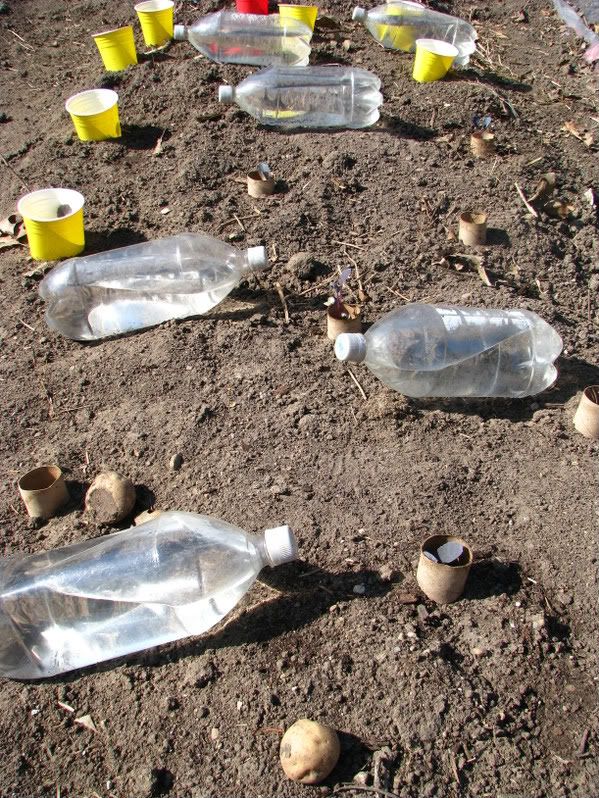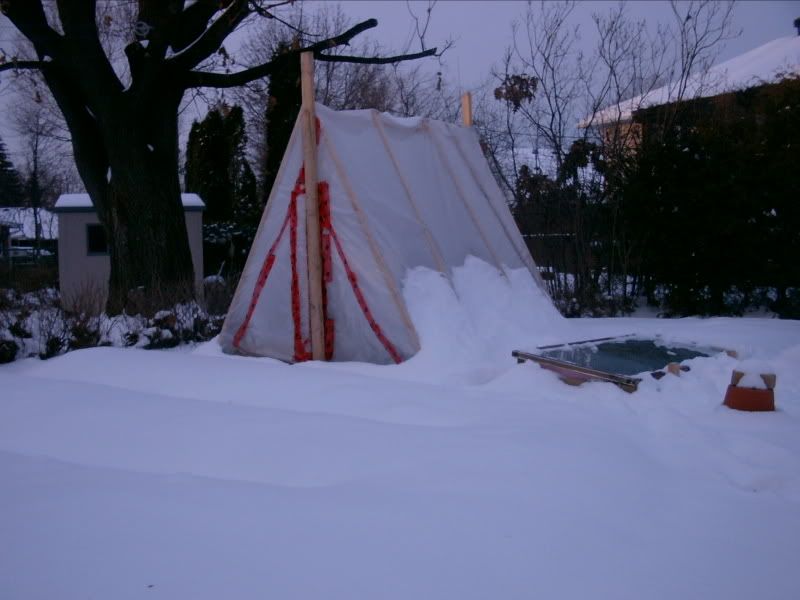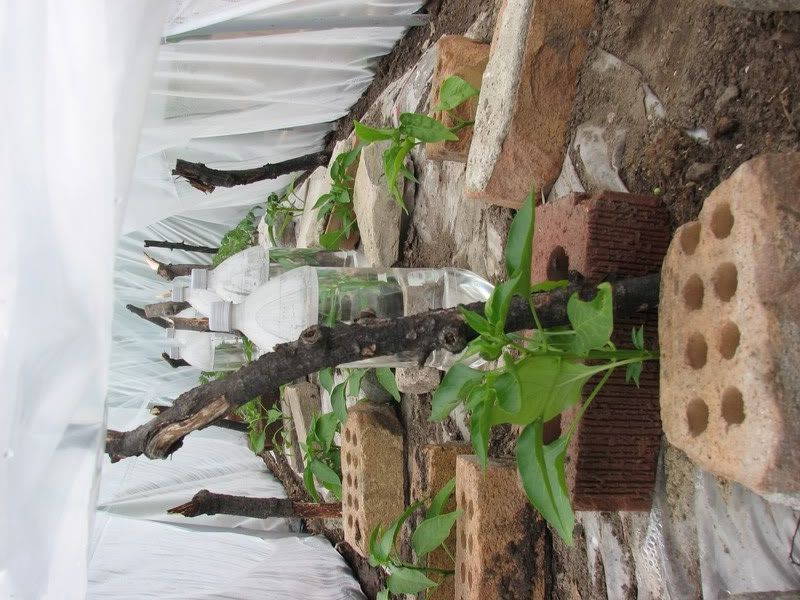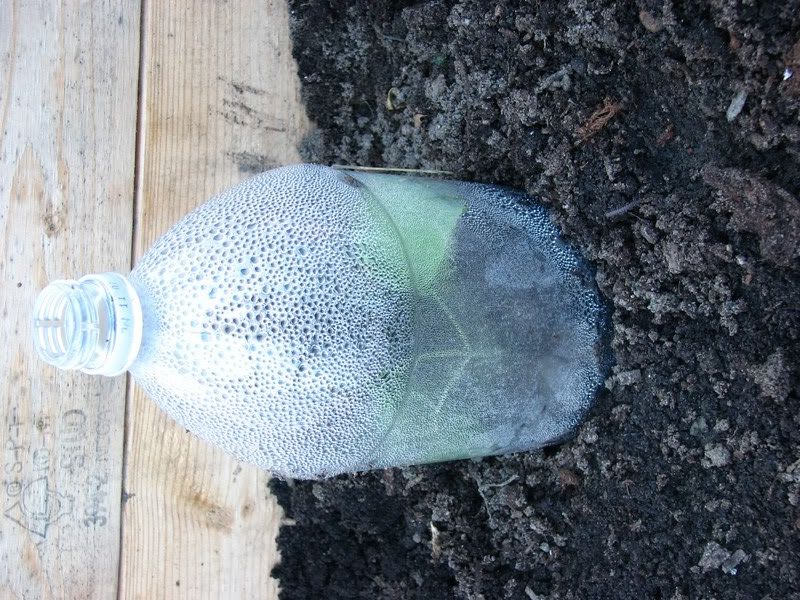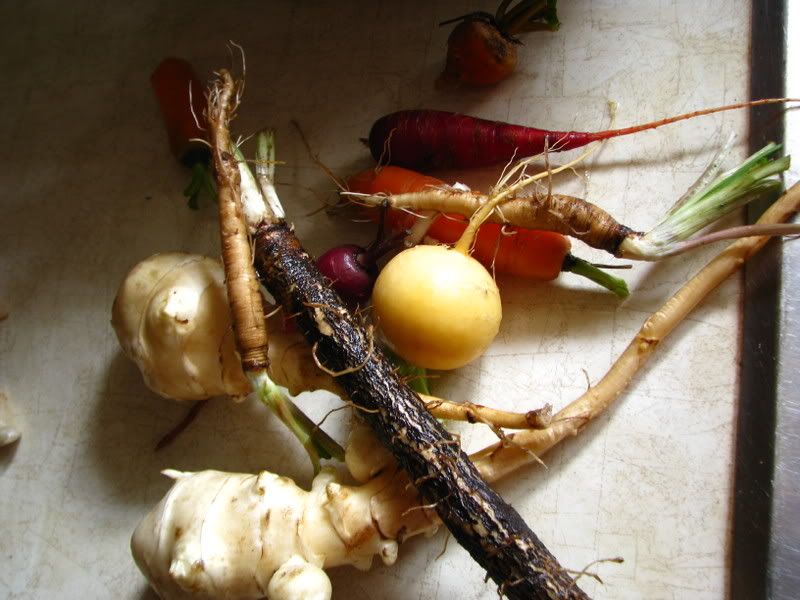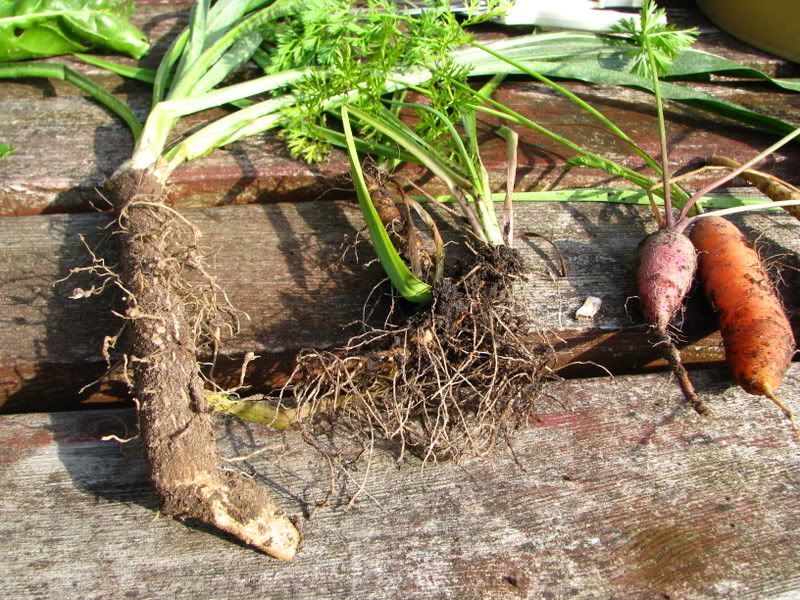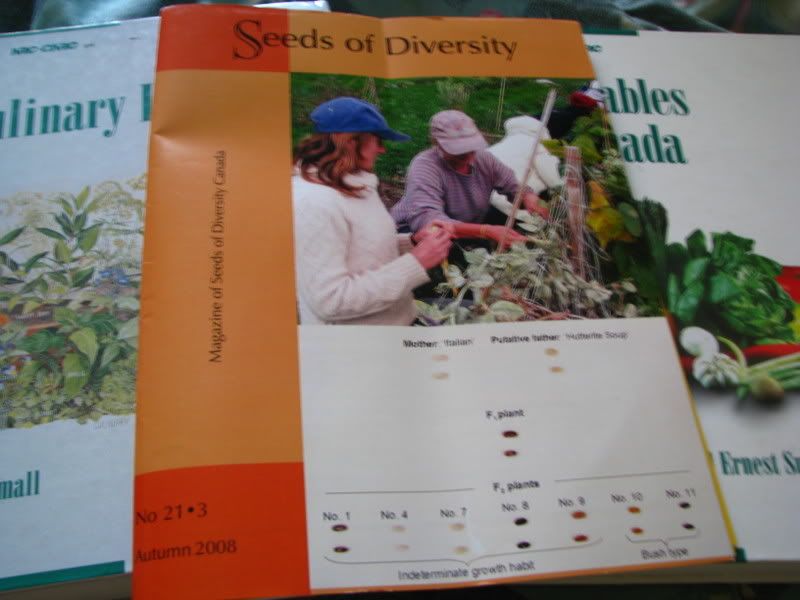Monday, December 29, 2008
Blog 'reprinting'
Think of that folks. Your blog is in my favourites but mine isn't. Actually, no, don't think of that.
... I encounter my blog reprinted in various odd sites. Some are collections of gardening information, one is about global warming (?) for my recent post on La Nina, and many are advertising sites that use my blog content as search terms to try to lure you to their site. For example, you can buy a coldframe from some place which uses my blog and its content as a trap door.
Shame, shame you reprinters. Of course, I am happy to have the traffic through gateway blogs but most of the time it just generates hits for their site.
How to tell my site from the others (what follows is obvious btw)?
1. I don't try and sell you anything. I try to give you seeds but sell no: did you see my seed list?
2. I try to be informative. Take this one as you like but I swear I like do research and stuff.
3. Every word and typo is my own finger stumbling.
4. Pretty pictures from my garden including the banner which is badly offset and drawn in Paint.
5. If you comment on my site, I'll visit yours and I'm not just saying that.
So now you know how to tell the authentic Ottawa Gardener from my imposters. Oh and normally I appear first in a google search. (Shortly thereafter Bifucated Carrot merely mentioning my site appears, but then he's google cool).
Sunday, December 28, 2008
Vegetables for shade
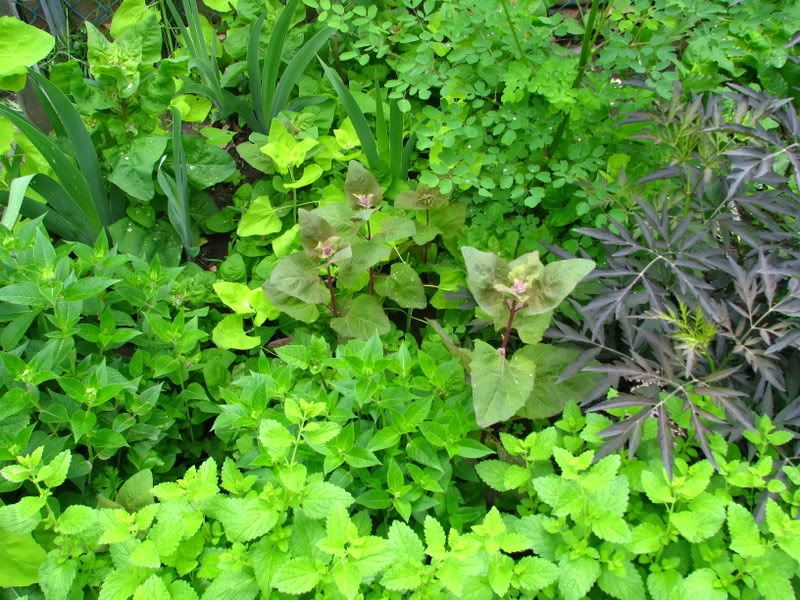
Orach, lemon balm, elderberry and friends in a part shade garden.
What the heck do you mean by shade?
Good question. A shady area can vary from getting no direct sunlight at all to being flooded in sunlight in the spring until a tree canopy leaves out into dappled shade to a garden that recieves 6 hours of sun. All of these gardens might be described by someone as shady along with many other variations. To find plants well suited to your area, you have to know exactly what kind of light you are getting: it's intensity, time (am or pm), duration, along with seasonal changes. Here are some quick and dirty catagories which I'm sure will only satisfy some of the reading audience:

Self-seeded corn salad / mache in 'woodland shade.'
Mostly sun: 6 or more hours of sunlight a day.
In this setting, you can grow most vegetables especially those that like cooler weather. It is best to have morning sun but mostly afternoon sun will work too. Avoid those that are borderline for your area because they need heat or a long growing season. You might find that some plants take a longer to mature than it says on the seed pack.
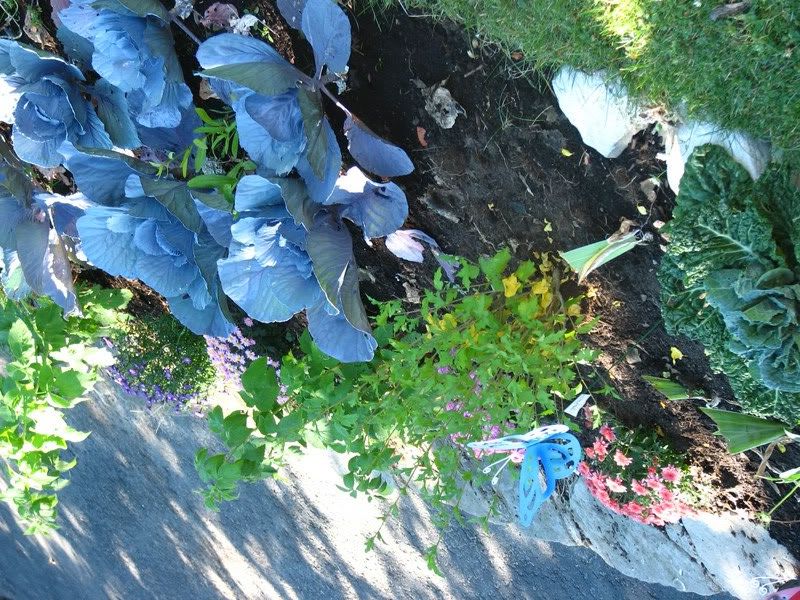
Alpine strawberries, raspberries (now I grow blueberries here) and even cabbage and lettuce that year grow in part sun, about 4 hours.
Part sun: 4 - 6 hours a day
Fruiting plants will not preform as well which includes tomatoes, and squashes etc... but most greens and roots will do fairly well. Look for varieties that are bred for short seasons and / or are eaten at the immature stage, ie. summer squash instead of winter squash.. Bush peas and beans often have a shorter growing season than their pole cousins. I have had potatoes grow very well in 4 hours sun. Jeruselum artichoke grow in our yard with about 4 hours of western sun in dry soil, and it produces abundantly. Many alliums, herbs, brassicas (chinese cabbage, brussel sprouts etc...) will thrive.
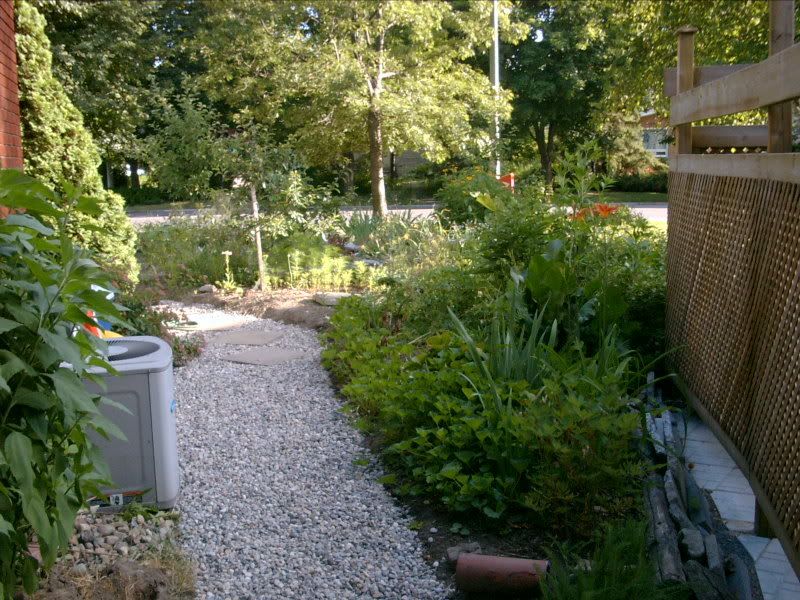
Jeruselum artichokes, egyptian onion, horseradish, daylily and rhubarb grow in limited sun on the western side of the house between two walls.
Mostly shade: Less than 4 hours - solid shade
Each hour less of sun will lower the possibility of growing traditional vegetables but in the least sun it may be possible to grow some greens that are quick to bolt like chevril, some woodland plants such as fiddlehead ferns and mushrooms. Dry shade will present further challenges.
Woodland shade - deciduous trees
If you have a spot in your garden dominated by deciduous shrubs and trees, look for edibles adapted to a woodland setting such as Giant Solomon's Seal, Sweet Cicely, Ramps / Wild leeks and claytonia. These plants are normally up early in the spring to take advantage of available light before the canopy leaves out. This is another good spot for very early spring crops like pea shoots or fast growing brassicas and a fall garden especially under a coldframe. You can even try growing early spring crops of lettuce and other vegetables that don't like the heat to see if they last longer into the summer season. For more on this subject, look into 'Forest Gardening.'
On the southern / eastern edge of your woodland site, you can plant more traditional vegetables.
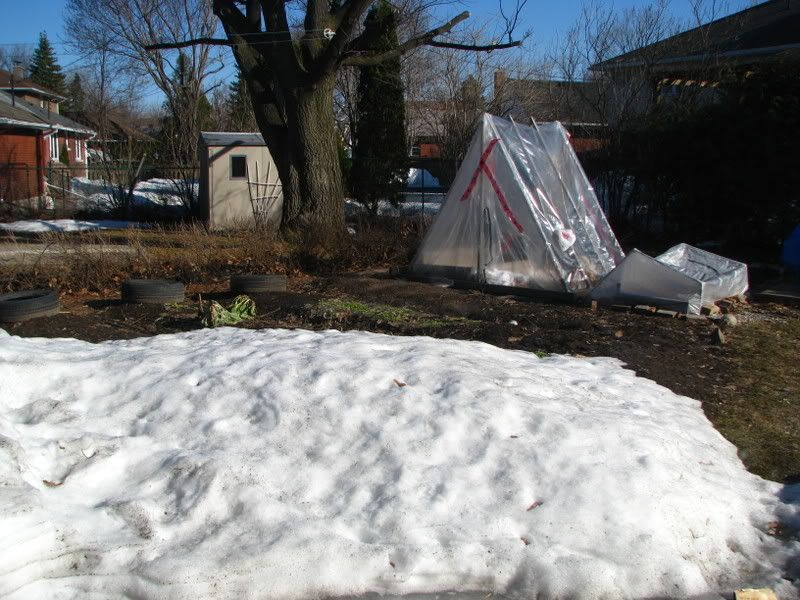
Coldframes located in full winter sun but dappled summer shade.
Techniques to increase sunlight
If you are stuck with a shady spot but would like to increase the amount of light you get, you can use several tricks. Firstly, if you can set up a reflective surface to direct some sun into the dark corner such as a light coloured wall, stone or water. If your shady spot is under a tree, you can limb it up (remove the lowest branches) or thin out the branches. Never prune more than 30% of your tree a year and really I'd do this very sparingly. Finally, always plant taller plants to the north of your patch so that they do not shade out the shorter ones.
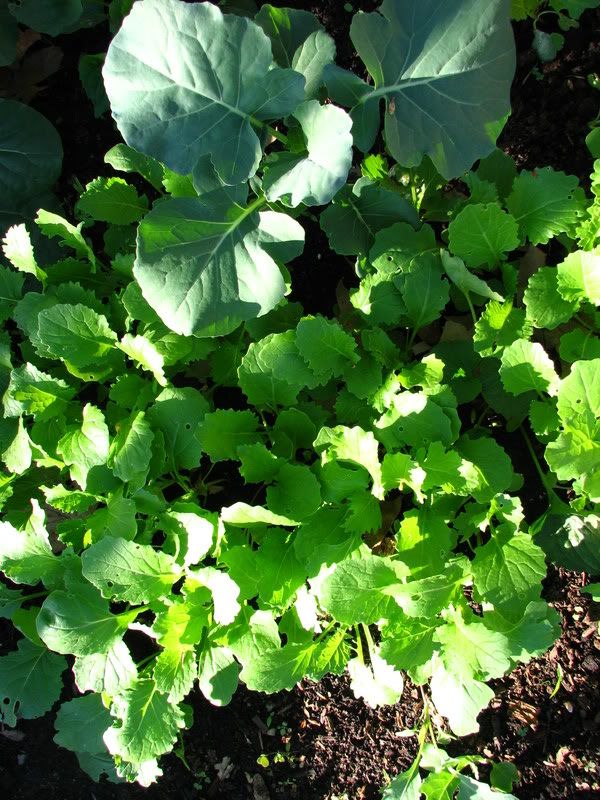
Young turnip and broccoli plants in dappled shade.
I may post some gardening plans soon.
Happy gardening!
Links
Plants for a Future - north facing walls and deep shade
Tuesday, December 23, 2008
Narnia returns to Ottawa
This year, in December, my back garden looks like this:
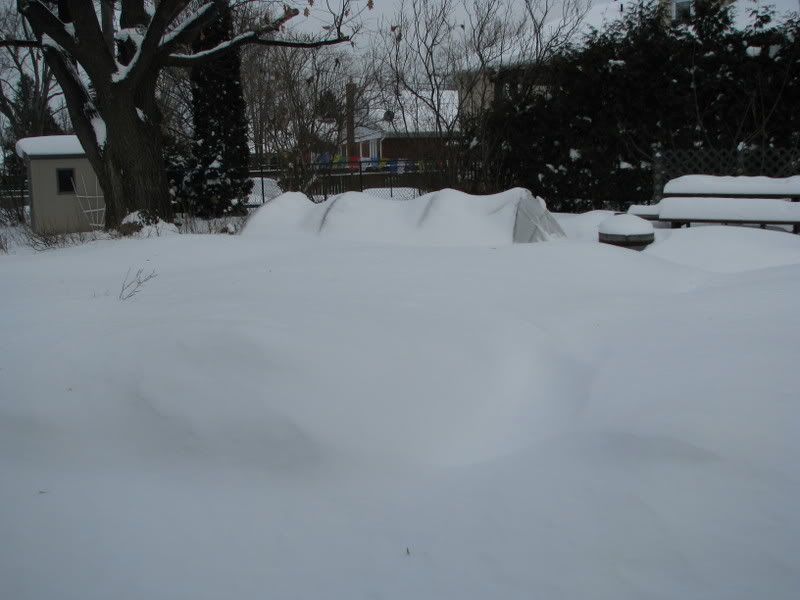
You can see the double wrapped coldframe as a lumpy hill in the back.
Seriously, I mean seriously. I know that I live in the great white north but it doesn't usually look like a white desert until January. Not only are we getting more than our fair share of snow (and I'd be happy to share with a snowless region wishing a white Xmas) but we are getting bone chilling cold with windchills nearing -30.
Global Climate Trends - La Nina
Last year, the snow mountains were associated with La Nina, a global weather pattern which brings cool, wet weather to the north east. Anyone attempting to grow tomatoes last year can vouch for the accuracy of that.
So is this year La Nina dos?
This blogger attemps to find out by using other people's internet published articles. For the most part, people are predicting a near-neutral / weak la nina event. Regardless of temperature predictions, both NOAA (National Oceanic and Atmopsheric Assocation) and the Farmer's Almanac predict higher than normal percipitation for Northwest.
I decided to get a Canadian perspective and went to Environment Canada's Weather Office which predicts cooler than average temperatures for the immediate three months. These current forcasts also say that it might be warmer than normal in the lower regions of Ontario in the all important run up to spring months but if I read correctly than it is not strongly statistically significant. However, like all forcasts, it is subject to change. We shall see how long it is before the lion of narnia arrives.
Wednesday, December 17, 2008
Alternative sources of seeds
Now that you are ready to give, why not receive? Gardeners are normally generous people and if someone lists seeds to give away that means they are expecting you to ask for them. Really. They aren't just kidding. Sometimes, they are merely great people who like to share and other times they are great people and they believe that seed saving and distrubition by the people for the people is an important political project.
Here are some places and organizations where you can learn more:
Seeds of Diversity Canada
Seed Savers Exchange
Blogger Seed Network
Plantcycle Ottawa
Gardenweb Forums
And if you are really into edibles including plant breeding then you might be interested in:
Homegrown Goodness
Let's revive the time honoured tradition of seed sharing and break our reliance on commercial seed to grow our own food. Many times, the only source for seed I was looking for has been from a fellow gardener not even from my beloved local OP / Heirloom seed companies. In the spirit of this let me repeat:
"If I write about a plant that reproduces by seed that you are interested in trying, email me (email is under my profile) and if I have extra, I'll send it along. You do not need to trade me anything for it. You do not need to send me postage if it is just a small order as I am willing to forgo a couple coffees a month for this effort. All I ask is that you consider doing the same one day. It does not have to be this year. Gardens can be fickle things and seed saving is a learning curve. If it reproduces vegetatively (ie, cuttings, prunings, tubers) then it will only be available around the Ottawa area for pickup but I am happy to suggest sources in your area if I know of them. I don't list all the seeds I have available in my availabe seed list as some I only have smallish quantities of most seed."
***
Interested in knowing more about saving vegetable seed?
Fellow bloggers at Grunt and Grungy's Garden are writing a series on seed saving.
Monday, December 15, 2008
Harvest Day - colder snap, chard reborn

Swiss Chard in double wrapped coldframe.
Two weeks now of -20 and lower have meant that the coldframe has gone into deep freeze. The florence fennel is definitely frozen from the bulb up but I have hopes for the taproot. The rabe is toast, the broccoli is shivering, the tatsoi is popping back to life and I think the slugs have made off with the mustard seedlings. My kale is covered in at least a foot and a half of snow (the ones in the coldframe were slug food. )The beautiful calendula that was in bloom has collapsed but it taught me the value of flowers in the coldframe if just to lift the spirit and I think I"ll add some pansies or violas next year. Onions looking bleek but I know they are far from dead and the minutina and corn salad are hanging in there. Radicchio is still alive by the looks of it, cilantro?, and the parsley is a polar bear, ie. bring on the cold! As for the chard and its friend bietina, they died back but the crowns are sprouting again as you can see in the above picture.
Thursday, December 11, 2008
Even More Plants: Drought tolerant, edible plants for the north - updated again!
As part of my extremely small gardening biz, I plan and care for gardens, with a special interest in edible and native plantings. In the winter months... oh who am I kidding... all the time, I obsess over client questions like 'what vegetables can be planted in the sand trap which is my front yard' or 'can I grow anything edible against the north wall of my house in the shade?'
Thankfully, the answer is surprisingly several and yes respectively, though I have to admit to making up these questions. Normally, people want to plant their edibles in sensible areas with at least 6 hours of sun and so on. However, I hate to think of any garden without something to nibble on so I ask myself these questions.
Drought tolerant, edible plants for northern sunny gardens
Generally the plants listed will require a well-drained soil in a sunny position. Not a complete list but here are some promising sounding ones:
Vegetables - perennial:
Prickly Pear Cactus - pads edible
Notes: A delicacy I have never tried but it is drought-tolerant. There are several types that are native to Canada and quite frost hardy.
Source: Gardens North
Nodding Onion (allium cernuum) - leaves, flowers, bulb
Notes: Several sources say 'very drought tolerant' so I look forwad to trying this out. It has a lovely pink flower and is supposed to taste good to boot.
Source: Gardens North, Edible Landscapes
Garlic Chives (allium tuberosum) - all plant
Notes: It is said to be fairly drought tolerant and does well in my non-irrigated sandy garden in the south side of my front yard. I have also heard of people growing it as a groundcover under trees - presumedly ones with open canopies. This is one tough plant so I don't doubt that it can take some punishment.
Source: Ask me, ask a friend. Someone you know has too much of this plant, various commercial sources including Ritchers who have an unusual pink flowered variety
Crambe (maritima & cordifolia) Sea Kale - young leaves, blanched shoots, young flowerbuds
Notes: Crambe maritima is seakale which should be hardy around here. It is going through its first winter in my garden so I'll let you know though it is mentioned in a gardening book from the Ottawa Valley. Crambe cordifolia may also be hardy around here and is known variously as flowering kale, giant kale or giant gypsophilia (baby's breath) according to Dave's Garden. Both of these plants are extremely attractive with large glaucous leaves and impressive sprays of flowers once they get going. They are drought tolerant because of their deep root systems. To ensure good root development, sow where you want it to grow.
Sources for seakale: La Societe des Plantes, Bountiful Gardens
Asparagus: new shoots
Notes: Sometimes listed as drought tolerant. This is because of their extensive moisture seeking root system. I would say that this is somewhat drought tolerant once established. It also prefers soil rich in organic matter.
Sources: various
Alfalfa, lucerne: growing tips, sprouted seeds
Notes: A nitrogen fixing plant with very deep roots that mine the subsoil. Compact salad plant or use for green manure to add a kick to your compost. It would make a pretty border plant and also attracts beneficials.
Sources: Ritchers, others
Jeruselum Articoke: tubers
Notes: Fantastic perennial food plant - pest resistant, drought resistant, will grow in light shade (gets about 4-6 hours in my yard and grows12 feet high with huge yields in droughted soil next to the western side of the house). I would ammend the soil with organic matter to keep up the fertility. The only caveats are that this plant stores sugars in the indigestible form of inulin which gives some people 'gas' and it does not store in a cellar well though I have developed a simple technique for storing which I'll write about another time. Maximillian perennial sunflower is a related species which according to the book Gaia's Garden produces smaller tubers and edible oil producing 'sunflower' seeds.
Sources: various, Mapple farm has the cultivar 'Volgo 2' which is less knobbly, plant small tubers from grocery store, contact me in the spring or fall for some.
Chinese Articoke: tubers
Notes: It is related to lamb's ear and is sometimes listed as drought-tolerant though it will produce better with more moisture. As they work like a ground cover, they might be nice to grow in and around other plants which would also shelter them a bit from drying winds.
Sources: Mapple farm
Sedum: leaves
Notes: Really, most sedums are edible. Surprised? Me too, but there you go. I tasted S. telephium (like Autumn Joy) that were shade grown and they were quite nice, lemony. I have no idea what they would taste like if grown in full sun but it is worth a try and they look great in the garden too.
Source: various
Yucca filamentosa & Y. glauca: flowering stem, flowers (bitter according to pfaf) and fruit
Notes: Too pretty to eat though I guess I could try the fruit. Very drought-tolerant.
Sources: various
Winecups or Poppy Mallow Callirhoe involucrata - roots and leaves
Notes: Have yet to try this one too, but the roots are supposed to be reminiscent of sweet potato. It's a mallow relative so the leaves are edible and are mucligenous according to pfaf like okra or some other cooked mallows. A true drought fighter, very pretty.
Sources: Cottage Gardener
Allium stellatum & Allium textile - whole plant I think
Notes: Prarie natives that can take dry soils. I don't know too much about these plants so you can check out Plants for a Future if you want more details.
Sources: Prairie Moon Nursery
Astragalus crassicarpus - plum milkvetch - seed pod
Notes: This plant gets an honourable mention from Gaia's garden about homescale permaculture. The plant looks like vetch but the seedpods look like itty bitty plums. It's also nitrogen fixing which means it would require less fertile soils. I've ordered seed so I'll let you know how it goes.
Sources: Prairie Moon Nursery
Psoralea esculenta - prairie turnip - taproot
Notes: When I was scanning Prairie Moon's seed list, I saw the name 'prairie turnip' and some googling revealed that it is considered very tasty. Yup, you guessed it. Seed will be arriving at my house for trial this spring. The plant looks like a small hairy lupin - another nitrogen fixer.
Straight forward wiki link
Sources: Prairie Moon Seeds
Eryngium maritimum - Sea Holly - blanched shoots, roots
Notes: Established plants are drought tolerant and they are also salt tolerant with an extensive root system that can be used to stabilize soil. I have never tried to eat this plant though I enjoy the blue flowered cultivars. I see this as a marginal vegetable as you unless you have a large population, digging up the roots would remove it. I am not sure of how many shoots you could blanch before you significantly lowered its growth potential.
Sources: various
Herbs - perennial:
Sage - leaves, flowers*Notes: Very hardy, very pretty and drought tolerant. A must for any garden.
Sources: various
Oregano - leaves, flowers
Notes: Golden leafed varieties are pretty. A distant relative of mint, need I say more? Yes, it will cover the ground in short order but it is delicious and hardy, as well as being pretty.
Sources: various
Thyme - leaves, flowers
Notes: From low growing mother-of-thyme to taller varigated varieties like lemon thyme (hardiness varies), these plants are lovely dainty, drought-tolerant perennials
Sources: various
Lavender - flowers, leaves (as a rosemary substitute, never tried this)
Notes: Used sparingly as a floral note in recipes or as potpourri. English lavendar (Lavandula angustifolia) is commonly used from what I read. Munstead is hardy in my garden.
Sources: various, Ritchers
Annuals
German Chamomile - flowers for tea
Notes: The first year I put in a garden in a sandy ant ridden area of my yard, very few but the most drought hardy plants did well and included German Chamomile that flowered happily for most of the summer. Self-sows
Source: various, Ritchers
Orach - leaves
Notes: Though it is reputed to be drought tolerant, I hesitate when I write this as it is a salad green that prefers cooler weather like its relatives in the spinach family. If grown in a hot, dry spot, I imagine that it would bolt to seed fairly quickly depriving you of weeks of tasty greens and giving you a shorter but still attractive floral display.
Source: various, Wild Garden Seed
Amaranth - leaves, seeds
Notes: There are some beautiful cultivars with coloured leaves. Generally, the green leafed varieties are used as a vegetable and the white seeded form as a grain but all are edible. Self-sows.
Source: various
Legumes: specifically chickpea, tepary bean, asparagus bean, peanuts and cowpea are drought tolerant but all prefer a long, hot growing season which northern gardens are often not blessed with. If you try these legumes, choose those that are selected for short seasons - often dwarf and small seeded - and cross your fingers. You can also space close together if yields are low to see if you get more seed per square foot that way. Heck, they may do well for you.
Sources: prarie garden seeds for tepary, salt spring seeds for chickpeas (winnifred's garbanzos did well for me, small, brown chickpea), valencia peanut is worth trying.
Wild roots - parsnips, wild carrot, chicories, burdock, dandelion
Notes: Many of these plants will grow in gravel if given half the chance and are often found in disturbed sites with poor soil. Though I know that some of them are listed as drought-tolerant such as burdock (cultivated varieties often known as Gobo), I imagine that drought would increase the strength of their flavour perhaps making them bitter. All of these are generally biennials except (some) chicory and dandelion that are perennials. Chicory and dandelion leaves are also edible. Again, leaves will be more tender if grown with moisture. I list these so you can try them if you like. If collecting wild, be careful not to confuse parsnip or wild carrot with some poisonness relatives.
Some more weeds: ox-eye daisy (edible leaves and flower buds), purslane (leaves, quite drought tolerant in my garden), common milkweed (pods, flowers, spring shoots edible, make sure you have the edible variety and check preparation of this plant), malva (young seed pods - cheeses, and leaves, look up your variriety), etc..
Misc. shrubs etc...
I am not going to go into any detail when it comes to the scaffolding of your garden, as lots of companies list drought tolerant, edible shrubs and trees, but here are some I bumped into while on my search: siberian pea shrub (lentil like seeds, invasive in some places), pinon nut, juniper (berries edible), saltbush (leaves, atriplex canescens: grows in Saskatchewan so may be hardy), seabuckthorn (berries)
Southern vegetables, northern gardens
When looking for traditional vegetables that are drought tolerant, note that many are bred for conditions of southern gardens which are also very hot so they won't necessarily do well in areas with cooler, shorter seasons. Of course, there will be seed adapted to short season, cold winter living such as plants that grow in the Canadian prairies but they will also expect a bit of sun. Obviously, what's adapted to your locale will work best.
Cool season crops such as cabbages or peas usually need a bit more water so though they are often good for areas with shorter seasons or less sun input but not drought.
Low watering veggies
If you plan on limiting supplemental watering in your vegetable patch, space your plants farther apart than suggested to give the roots more space to search for water. Plant cool season crops or crops that prefer a good watering in sunken beds that gather water. This will also create a cooler microclimate. I find that dotting these plants near the 'trench' cut edge of my garden border improves their growth. Mulching with flat stones will also help keep the ground cooler and wetter while absorbing heat to be released at night thereby moderating the microclimate. Generally mulching will help maintain soil moisture. If you use organic matter as mulch, it will break down and mix with the soil improving its texture and moisture retention.
If you live in an area that experiences frequent drought, then plant your veggie patch in place sheltered from the prevailing winds (plant a wind break if need be - jeruselum artichoke can act as a herbaceous one though it is invasive so best planted 'out of the way' or somewhere contained). You can also contour your beds to direct water flow and to prevent it from escaping. A pond or rainbarrels will help collect extra water for irrigation in dry times. You can also recycle your greywater.
Use drip irrigation to make sure the water goes just where it is needed. Deeper, infrequent watering will help edibles to develop deeper root systems that will further help them tolerate drought. Morning watering is prefered as it lowers evaporation but also allows plant leaves to dry out keeping foliar diseases in check.
And finally, allow plants that root on the stems like squash and tomatoes to sprawl on the ground further increasing their ability to mine water.
***
Now it is time for me to hit the drawing table to produce some mock plans for a dry front yard edible patch. Who knows, next year someone might ask for it.
Search terms that might help: xeric / dryland / dry farming / drought-tolerant vegetables / edibles / herbs. Let me know if you find something else!
* Some people will react to the pollen in edible flowers so use cautiously.
Friday, December 5, 2008
Giving up - seed and food thoughts
"Nothing is really organic and everything is modified anyway."
"You can get unmodified seed."
"Really?"
"I can give you some."
"Talk to me in the spring."
I've shortened it a lot just so you wouldn't get too bored but the point is that she had metaphorically flung her hands up in the air figuring that she might as well jump onto the Big Agri treadmill 'cause there was no real alternative.
I know that most readers of this blog are aware that there are alternatives. So this is more of a reminder that what we know is not what everyone knows. Once again, I think the key is both on the ground and in the air. We have to continue to push our saved seeds (complete with advice on how they can save their own from them) and demonstrate how we can achieve success in our gardens without relying on death-icides and chemical fast food for our plants. Normally, I give encouragement on how to plant your edibles in the curb side of your house and if you haven't gotten up the courage to add cabbage to your front beds then now's the time. Seeing is believing. Share your seed, share your food, share your ideas.
We also have to continue to use any access to media to let people know that more and more traditional farmers are interested in what was previoulsy considered alternative or cultural practices to improve the growth of their crops. Read, learn and disseminate my friends. Our work is not done.
Getting political and dirty
"Quebec is part of my Canada
and part of my coalition."
To all Harper supporters, do not let your government use anglophone fear of separatists dividing Canada to blind you to what has just happened. A minority government did not have the support of the house and instead of admitting defeat at the confidence vote, they called 'time out.' If this was a game of tag, then I'd demand to see the broken limb. Oh wait, what is broken is the faith of the people in democrocy and no by that I do not think that the coalition was attempting anything undemocratic. The truth is that everyone in parliament was voted to that position: Conservatives, NDP, Liberal and the Bloc. If the 'left' want to work together to create an legal alternative government that is willing to run a deficit and present a real stimulus package like... oh... everyone else suffering from recession, then I say they not only would have the support of the house but my support as well.

Monday, December 1, 2008
Harvest Day - someone else's potatoes and sprouting celeriac
Canadamike from Homegrown Goodness popped round my place with a bunch of potatoes from his garden and I very much appreciate it. In the lingo of my husband, 'muy amable.'
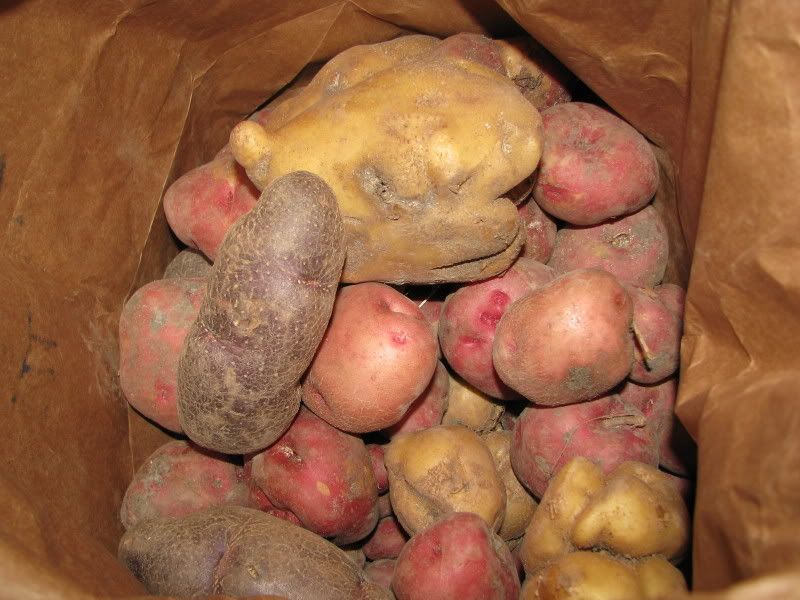
There were lots of goodies inside for eating but it will be hard for me not to save plenty to grow out next year. I can't help it. I love growing stuff!
(P.S. I found those darn chickpeas)
Sprouting Celeriac
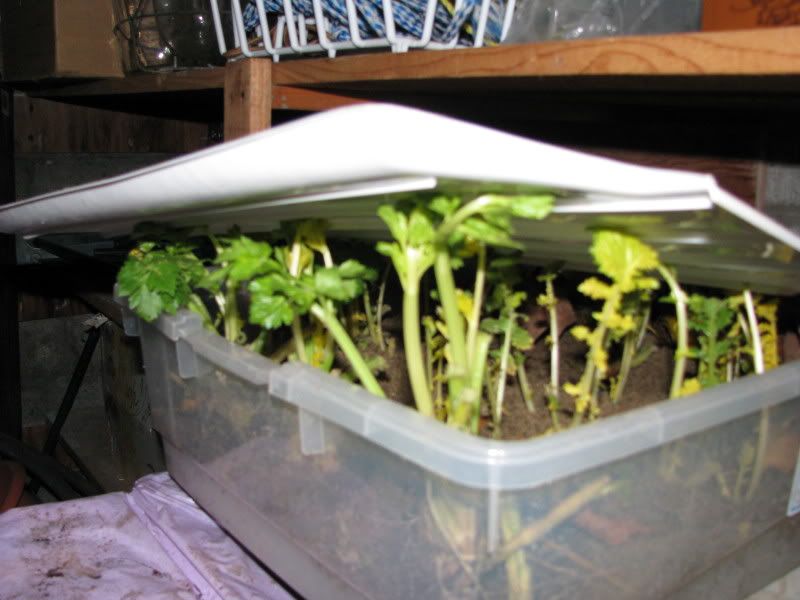
Mind the fuzzy picture. This is celeriac trying to escape the cellar by sprouting. I think I'll have to cook up these forced greens. In the meantime, I'll have to store them some place a bit cooler until the real cold weather arrives in Ottawa and the temperature in my cellar drops to its usual level of just past frosty.
Links
http://www.earth-house.com/Disaster_Readi/Sanctuaries/Root_Cellars/root_cellars.html
Monday, November 24, 2008
Harvest Day - cold snap and the coldframe
Here is the ground in the garden today:
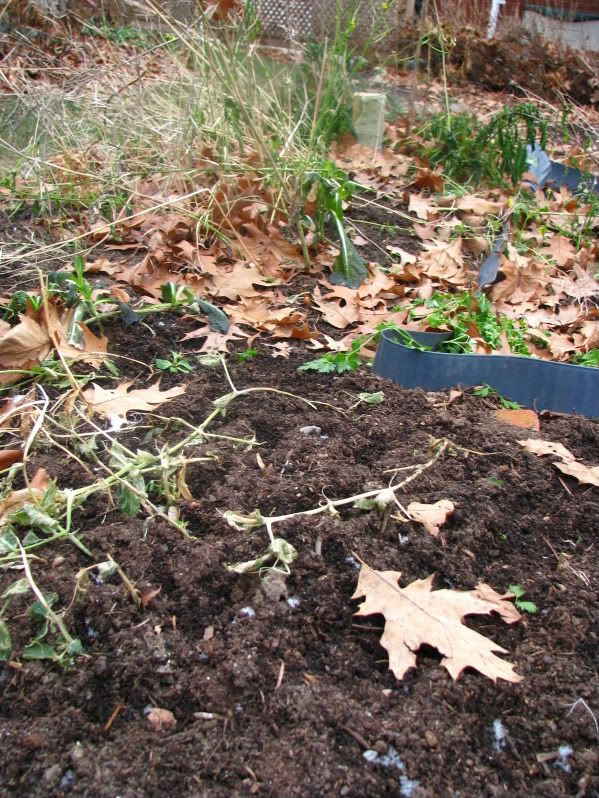
Pea shoots, mustard greens and kale in the frozen garden.
My polytunnel is usually a peaked structure that I can stand in but some changes meant that it is temporarily a low tunnel covered in vapour plastic over commercial coldframes. Next year, my hubby and I will be designing and building a more interesting and insulated greenhouse and I look forward to it!
Meanwhile, how are the plants inside?
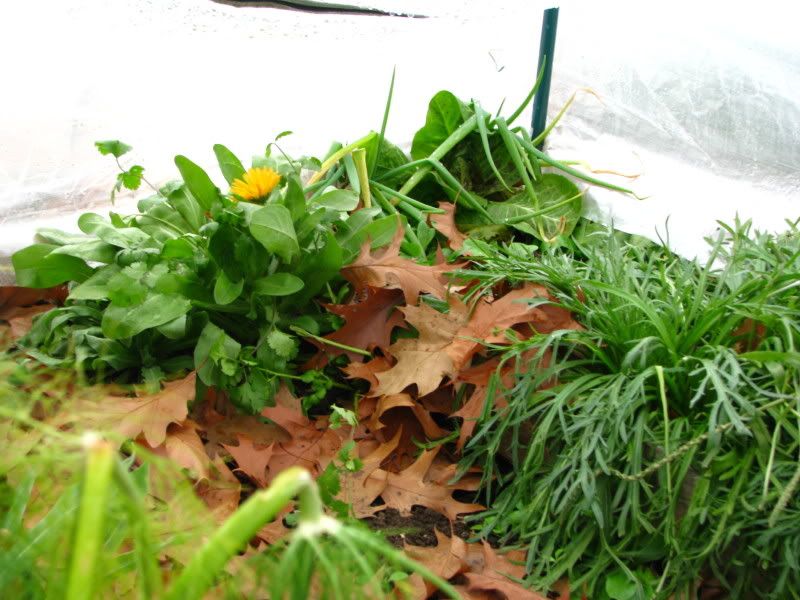
Calendula in flower, coriander, bunching onion and a radicchio I think, along with others.
Alive!
The florence fennel which some suspicious, though published, print sources say is hardy to zone 4 (I think the other quote of zone 7 is probably more on the money but we'll see) has broken tops and minimum cold damage and the chard, along with some other plants, have fainted but I know the chard for one will recover quickly. All in all, things look not too bad. This week the temps will be closer to normals for this time of year, hovering around 0C, which might allow for some recovery.
I'll be cleaning off snow tomorrow.
Wednesday, November 19, 2008
And another thing... season extension - edited
Just thought of some other great ideas for season extension that I forgot in my previous post.
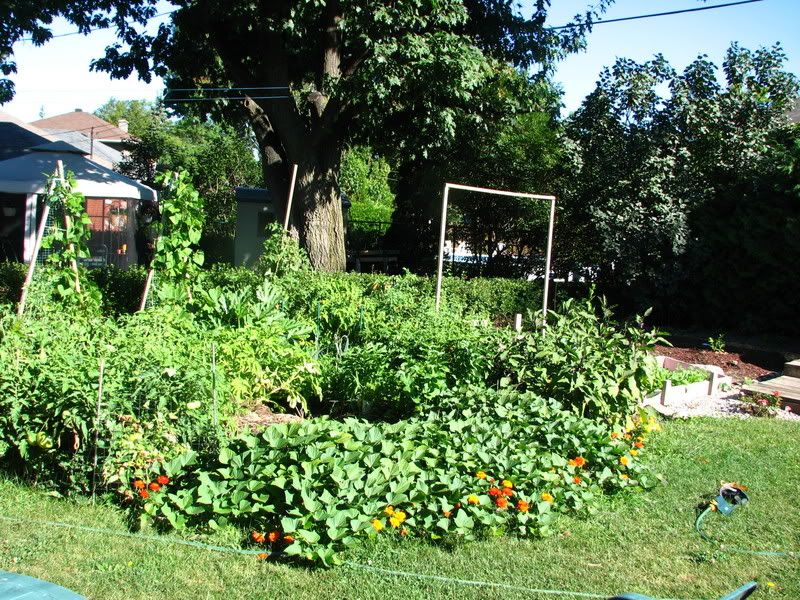
Garden 2007, I think. See the tree in the photograph - read the third paragraph to find out its important.
Site of garden
If you haven't already comitted to a place for your veggie patch then look for a place that gets at least 6 hours of sun (normally on the south / souteast corner). If you have a wind break on the north and west side then you'll create a sunny, sheltered microclimate. Evergreens make great wind breaks but some productive bushes work too. Another thing you could do is to add a stone or brick wall on the north side (this will be south facing as you put your back against it and face south) of your garden to catch heat. If you are lucky enough to have a brick walled house with a south facing wall then you could build a lean-to greenhouse against it and I will be very envious of you.
Other important aspects of citing your garden are that the soil is close to neutral pH and is well drained and fertile. A well drained area where the grass grows most lush often will work well, assuming that it has adequate sun. Of course if you have only poorly drained, partially shaded ground or concrete, edibles can still be grown. I'll write a post soon.
Raised beds
These will heat up faster in the spring. Also if you slant your beds so they create a slight south facing hill, you'll also increase the warmth and growing season.
Plant near a polite** tree
Okay, let me be contraversial for a moment. I have a garden that is on the north-eastern side of my yard with a giant oak tree due north, partially overhanging so you know that oak roots traverse the whole of the veggie patch. Produce grows with heady abandon in this garden nonetheless and the tree helps. Hey? Didn't they teach you that you shouldn't place a vegetable patch near a tree. Well, take heart urban gardeners who have no choose but to grow their food with loaming shadows of nearby trees, it can be done. My tree casts little shadow because it's on the north side and it isn't one of the greediest rooted trees, but best of all, its root system warms up the soil early in the season and keeps mild frosts at bay late in the season. Seriously, I have seen ground frost everywhere but around the root system of this oak. I guess it acts a little bit like a heating cable once the sap gets running in the spring and before the tree is dormant in the fall. Crazy cool eh?
It also drops an abundant mulch of oak leaves for my pathes. I have yet to notice problems with soil acidity though I do add add compost and manure so maybe it evens out. And if that wasn't enough, according to Roots Demystified, the tree can even help water the garden - but you'll have to read that book to find out the details. It's available at the Ottawa Library.
** Bishop's Homegrown made a great point and is one of my favourite reasons for comments - to improve and expand the web of information. Polite tree means one that does not exude growth restricting hormones such as black walnut and is not a greedy feeder so that very little has the luck to grow beneath it. If grass, perennials or other plants grow well 6 feet out from the trunk (right beneath the tree will be pretty shaded) then it'll probably be fine to plant a veggie patch nearby. Remeber, that if it is to the north, it won't cast as much shade.
***
paper on wind breaks
Sunday, November 16, 2008
Fall Garden and Season Extension - a question
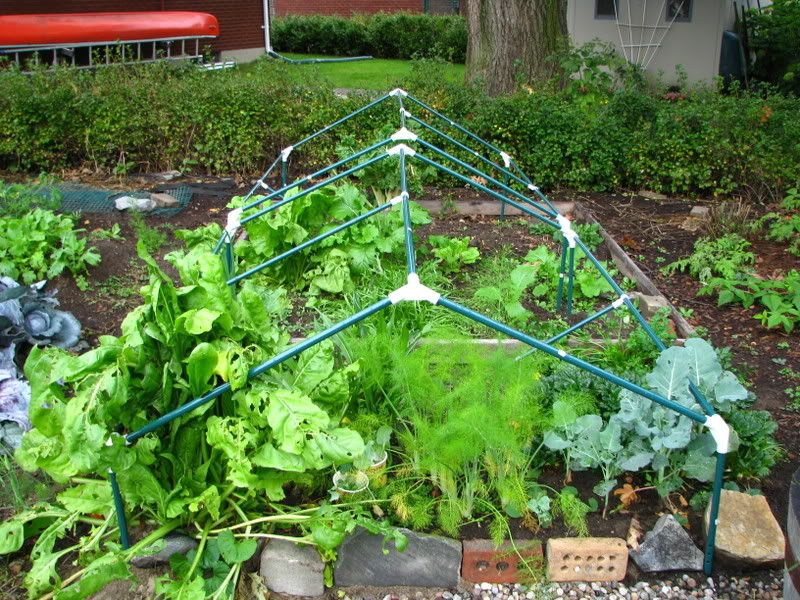
Fall crops overflowing the soon to be covered coldframe.
Growing Season - frost to frost?
Gardeners often describe their growing season as lasting from the last frost to the first frost but another way to look at it is from when the ground is workable until it is frozen in the fall. The frost to frost season in Ottawa is 4-5 months long but the workable season is around 7-8 months long. That's a heck of a lot more time to grow stuff. If you add some simple season extension devices like coldframes, tunnels, row covers and plastic mulch, you can add another month or two to that season bringing the possible amount of growing season in Ottawa to 9 months of the year!
Tomato - the gateway vegetable
When it comes to growing your own, tomatoes rank high in my list of gateway vegetables. As people often start their veggie patch on things like pumpkins, tomatoes and cucumbers, they make a habit of not planting or seeding until after the last spring frost date which in Ottawa happens sometime in mid-May (occasionally as late as early June and as early as late April). As the snow hangs around in Ottawa sometimes into April, it may mean that the ground isn't really diggable until the beginning of April anyhow so people just wait until the magic long May weekend to seed their carrots and lettuce as well.
By the time those tomatoes are killed off by the first frosts near the end of Sept, the lettuce has long gone to seed and those cabbage starts bought at a garden centre in those first warm spring days have been eaten up. The leaves fall and the season seems well and truly finished but it does not have to be that way.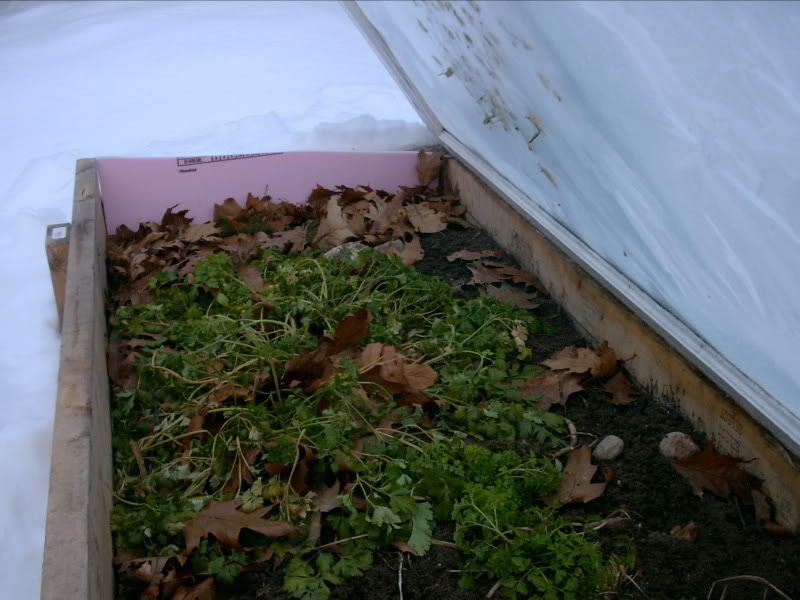
Coldframe with a healthy crop of parsley inside.
Some like it hot, many take it not
Members of the tomato family which such as potatoes, tomatillos, ground cherries etc... take no frost so transplants are placed out after the last frost date. Most vining crops such as pumpkins, squash, and beans are the same so they are also seeded when temperatures exceed 4C at night.
However, there are some vegetable families that will take it a lot cooler and these include most of the brassica family (mustards, cabbages, kale, rocket), spinach/goosefoot family (orach, spinach, swiss chard, beets), and the composite family (chop suey greens, chicory, lettuce). Many other root crops can be started a few weeks before last frost and several varities of legumes can be planted as soon as the ground is workable such as peas. The allium family has lots of examples of cool weather lovers from garlic, leeks to wild and perennial onions.
Cabbage started transplanted early with cutworm collars (those toilet paper rolls and cups) and pop bottles filled with water to help catch some heat for release at night (crossed fingers) to help moderate the temperatures. On really cold nights, I cover with a row cover or frost blanket.
Most good gardening books will have a calendar in the back which tells you when you place crops in the ground but here are some rules of thumb that I use.
- Peas and parsnips as soon as the ground can be worked
- Cool weather greens like spinach seeded under cover (coldframe and greenhouse) when soil is no longer frozen which can be as early as March 1
- Plants that can take it cold like broccoli or leeks but will bolt if exposed to temperatures that are too cold planted very early but under cover
- Fall gardens are planted mid-summer and include brussel sprouts, short season cabbage, kale, mustard, rocket, endive, lettuce, root crops, chicories like radicchio, mache, claytonia, florence fennel etc... I don't plant all of these out July 1 but plant according to how long it takes to mature a crop either outdoors or in a coldframe if that's where they are going. I also tend to start the cool weather loves in the light shade of a taller plant so that they are not exposed to full force of the summer sun. Some of the very fast baby leaf greens are started in August or even September.
- Some plants started way in the spring can be left in the ground until very hard frosts or heavy snow threatening such as long season cabbage, parsnips and celariac.
- I leave roots like carrots and jeruselum artichokes in the ground until frozen ground is on its way. You can also heavily mulch the ground over carrots, and beets etc... so that the ground is diggable later into the season. I use autumn leaves for mulch but eventually I bring in all my roots so I don't have to uncover them in the freezing cold outside. They are kept in a cellar under our stairs.
A list of cold hardy plants can be found in The Four Season Harvest by Coleman.
Polytunnel, Ottawa Gardener style - it will be changed into something all together different next year. Notice that it has a peaked roof. That's to prevent it flattening under our sometimes really heavy snow falls. A gothic roof is supposed to work too.
Under Cover
Some days it looks like I am growing plastic in the garden what with the polytunnel, cloches and row covers covering everything. I use coldframes and low tunnels to grow salad greens earlier and later into the season. A coldframe is a box of some sort made of wood or even straw bales with a top that is called a light and is made of any material that can let in sunlight such as an old storm window or plexiglass. My current coldframes are aluminum frames stretched with a kind of clear tent material. A low tunnel is nearly the same as a high tunnel except for - surprise surprise - the low one isn't as tall. They are both simple greenhouse structures that are made by stretching clear plastic (I use vapour barrier) over a frames - normally a hoop shape. Most years, I build a polytunnel / hoophouse / high tunnel overtop of my coldframes to increase the warmth inside. This is a technique I first read about in The Four Season Harvest by Coleman. Depending on your climate, you can just use a polytunnel to protect your winter crops from inclement weather and to increase the warmth for hot season crops like melons.
In the spring, I mulch the ground with clear plastic to warm the soil for some crops that are marginal for Ottawa including melons, and sweet potatoes (old blog). This also greatly improves the growth of peppers, eggplants and tomatoes as well. Ken Allan, from which I learned about this technique, also uses it for basil.
Black tire was covered with plastic to start melons (plastic mulch next picture).
As I often try to push the envelope and plant out my tomatoes in mid-May or even earlier, I put up a simple low tunnel frame around the bed so I can toss on some plastic if a late frost threatens.
I also use row covers to exclude insects and to improve growing conditions of early crops of leeks and brassicas like broccoli. A row cover is a light floating poly spun material. It can either be laid loosely ontop of the crop, with the edges secured or be laid over a frame. It will offer a couple degrees of frost protection. For cabbage, lettuce and sometimes vining crop transplants, I have used large water bottles, or just pop bottles, that people toss in two ways. With the bottoms cut out they make great cloches which are essentially mini coldframes and with filled with water and placed around plants or in the polytunnel the water inside gathers the day's heat and releases it at night. I have also used frost blankets (the kind used to wrap evergreens) to throw over my coldframes on extremely coldnights as insulation. Speaking of which, if you have solid insulation laying about, you can also put this over a coldframe when the mecury drops to ridiculously low levels.
Plastic mulched ground, low tunnel and bricks to catch heat.
A list of frost hardy plants that have worked for me
1. Mache / corn salad - amazing! It will last through the coldest weather in a coldframe and in mid-summer, it will reseed itself to start next winter's crop.
2. Claytonia
3. Beets and beet greens. I find these will last until the true winter cold hits but then the root starts to become mush.
4. Swiss chard - under double cover (coldframe plus high tunnel), this has survived extremely low temperatures.
5. Kale - dies back in the middle of winter but resprouts in the spring. In the garden, I have had several kinds overwinter under the snow.
6. Brussel Sprouts - survived and cropped under the high tunnel
7. Cabbage - I have never tried to overwinter a cabbage with a full head but those that have been cut and are reheading will survive under snow cover fairly well. In the polytunnel, I have had them do well until I pulled them mid-January.
8. Chinese cabbage will live until the really cold weather
9. Bok choy types grew well when seeded early in the coldframes
10. Tat soi types seem to take snow and freezing
11. Collards lasted most of last winter outside until the -20s with depleted snow cover.
12. Turnips - grow fast and crop well in the fall / early winter in coldframes but can't survive extreme cold.
13. Kholrabi - grew well but froze solid and was unusable in the height of winter. Can be seeded early in a coldframe.
14. Egyptian onion / green onions - do well in a polytunnel / high tunnel
15. Leek transplants survive extreme temperatures in my high tunnel as baby plants and later in the early spring garden under a row cover. I didn't have any bolting which sometimes happens when exposed to long periods of cold.
16. Broccoli - cropped a pop bottle cloche and coldframe while there was still some snow outside.
Pop bottle cloche.
17. Cabbage - does well if planted while still a threat of snow but ground is thawed under a pop bottle cloche.
18. Spinach - does very well seeded early in the coldframe or in the garden
19. Peas - can be started very early in the high tunnel or garden. I grow a late crop for pea shoots in the fall.
20. Carrots - about 3/4? overwinter if given half the chance. They are often useable once the ground has thawed in the spring.
21. Parsnips - cold hardy is their middle name
22. Chicory - Green leaf types seem to overwinter in my garden - I'll write more after some more experimentation ;-)
23. Lettuce - Can be seeded early in the coldframe but grows slower than spinach. Good to transplant with long season cabbage as they are harvested while the cabbage are still small.
24. Rocket - handles the cold.
25. Parsley - Only had to plant this once and it has maintained a very cold hardy troop in my garden ever since, reseeding itself.
26. Mizuna - In Ottawa this crop is ideal as it seems to take the modestly warm summers we get and extreme cold under the coldframes
27. Dandelions - If you enjoy these, they will survive quite nicely in the coldframe.
28. Minituna - related to plaintain - perennial, self seeding (I haven't seen that yet), cold hardy and good in salad. I also use it as a pot herb.
I'll add more as I think of it.
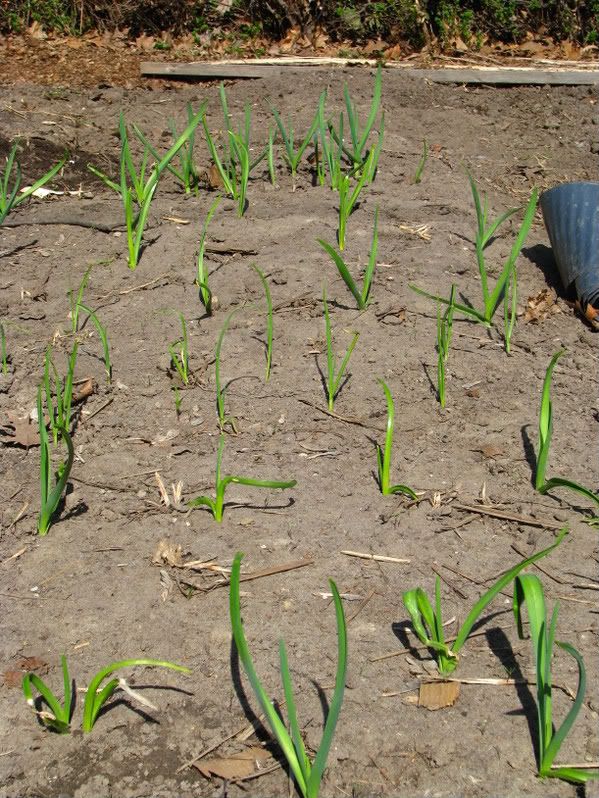 Fall planted garlic beats the weed competition by starting growing again very early in the spring. I replace this early.
Fall planted garlic beats the weed competition by starting growing again very early in the spring. I replace this early.
Monday, November 10, 2008
Harvest Day - cool cabbage, leaves of plenty
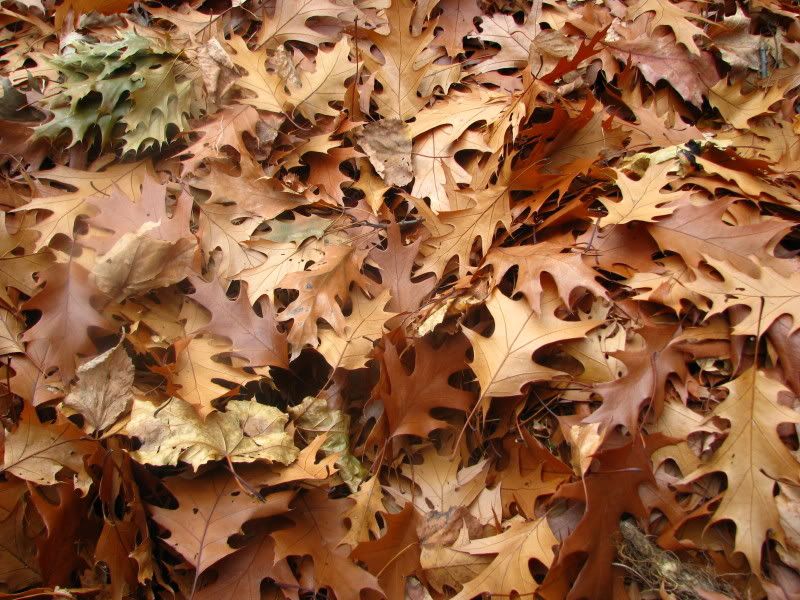
Oak leaves from the two very generous trees overhanging our yard.
This harvest day, I took in the last of the leaf bounty. The end of my driveway lacks the usual row of 10 yard waste bags as mine are spread out on my perennial beds and on the pathes of my vegetable gardens. I had quite a surplus this year as I raked up all my neighbour's leaves (they were ill and as I usual scam their leaf bags after they've done all the work, I figured it was karmic time for me to help collect them) so I also have extra high piles of leaves in the back turning into leaf mold.
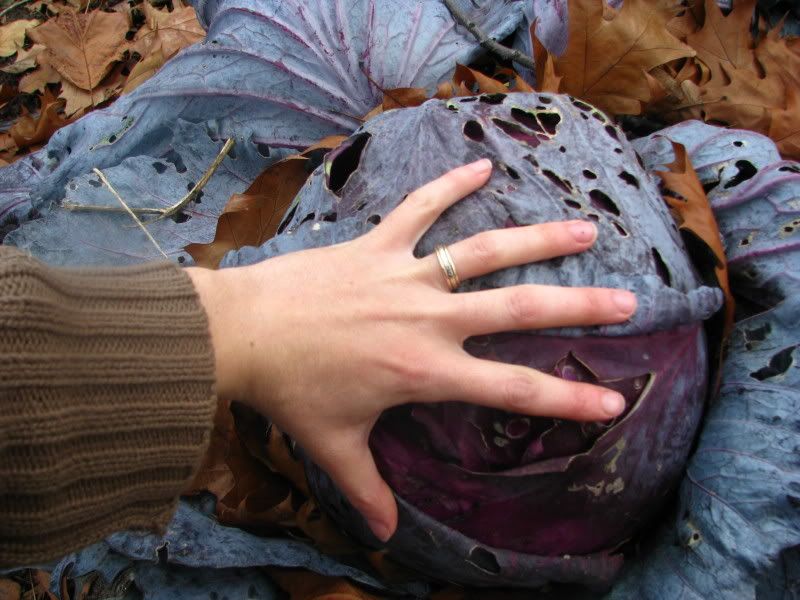
Cabbage versus hand. Oh and that's no petite feminine hand, I outspan some guys.
I would also like to draw your attention to this massive cabbage. I know that they can grow bigger but I grew this one. Even with those chew marks, isn't it gorgeous? Most of my cabbages were the normal 2 year's old head size or smaller, which I expect with my tight spacing. But this one was planted near the edge of the patch and if I remember correctly, its neighbour was eaten by something so it had more room than the others. So now that I've managed to grow this Mammoth Red Rock, what the heck am I going to do with it?
For more on my
Friday, November 7, 2008
Brassica names - perennial biennial, oh what the h*ll
The Intro - useful for seed savers*
Brassica
Let's start with the basics. Brassicacea is a large family including ornamentals such as sweet Iberis, and honesty plant (lunaria) and weeds such as hedge mustard and pepper grass. It also includes many common garden vegetables such as broccoli, and turnips.
The brassica genus -
interjection: The cross-language snob talk plant is like this 'Genus species'
- seems to highly represented in the safe and tasty category of plants across many different species. Plants that are in the species can cross pollinate one another creating weird (and sometimes wonderful) hybrids. However, the general rule is that those are different species, even though they have the same genus, will not cross (rules were made to be broken ;-).
These veggies fall under the following Genus species names - by no means a complete list:
Brassica oleracea: cabbage, cauliflower, broccoli, 9 star broccoli, sprouting broccoli, chinese kale, broccolini, white flowering broccoli, marrow stem kale, jersey kale, walking stick kale, palm leafed kale, perpetual kale, curly kale, brussel sprouts, European kale, collards, kholrabi and wild cabbage.
I am sparing you the variety name as they are quite complicated but, for examle, brassica oleracea var. botrytis is cauliflower versus Brassica oleracea var. albogladbra for white flowering broccoli. As these are all members of the same genus and species, they can all cross with each other. For more information, go to Sorting Brassica oleracea names.
Brassica napus include Siberian kale, hanover salad, rutabaga, rape and canola.
Brassica rapa (synonym campestris) include turnip, seven top, italian kale, mustard greens (some forms are in Brassica juncea), rapini (some forms are in brassica oleracea), broccoli rabe, chinese cabbages, bok choy types, tat soi type greens, holland greens, and mizuna.
Brassica juncea: Indian mustard greens
Presumedly as mustards in the Brassica juncea and Brassica rapa are different species, they will not generally cross with one another so you could save one of each type in your garden assuming that both can flower at the same time and yet still come true from seed.
Other edible Brassicacea include:
Eruca sativa: rocket / arugula - sylvetta can be perennial
Barbarea verna: land cress
Raphanus sativus: common radish
Armoracia rusticana: horseradish - perennial
Crambe maritima: sea kale - perennial
Possible perennial brassicas
9 Star Perennial Broccoli
I have never grown any so called perennial brassicas but I have heard of them. Representing the edible flower head form of brassica, commonly known as broccoli/cauliflower is 9 Star Broccoli. I understand that it is only perennial as long as you prevent it from going to seed. In plant terms this is sometimes known as monocarpic. Even then, I hear that it only lives for about 2-3 years. It has loose, white heads which look to me like cauliflower. I don't know if it could overwinter in Ottawa but heck if my mother living in Paradise... I mean, BC gets some seeds, I'm going to give it a try.
Source: Seeds of Victoria, Thompson-Morgan
Sea Kale
For blanched shoots, you can try Crambe Martima or Sea Kale. It is a true, long lived perennial with white, wavy silvery leaves and typical sprays of brassica flowers after 4 years or so. It is mentioned in an old time book on Ottawa Gardening so I know that at least one variety is hardy around here.
Source: 'Lily White': La Societe des plantes, Bountiful Gardens
Perennial Kale
A perennial leaf verison of brassicas was by far the hardest to track down. I got my first lead at the Plants for a Future website, which uses the latin Brassica oleracea ramosa (or branched kale?) that details useful perennial plants. They listed three cultivars Ragged Jack, Thousand Headed Kale and Daubenton. The first is a bit mysterious because it is a synonym for Red Russian Kale which as far as I know is generally a biennial unless this is some other purple, wavey leafed cultivar of perennial kale rather than the usual 'ragged jack'.
Thousand Headed Kale is, according to one supplier, a fodder kale. My search has lead me to believe that it is a) not that winter hardy or b) in mild areas can live for years? One growing source called it 'hunger gap kale' which is promising and it seems to be grown for its flowering shoots produced early in the year hence the 'thousand headed' name. Pentland Brig is a plant produced by crossing Thousand Headed Kale but I have no idea of its perennial status, however, this website, suggests that it shows promise.
Source: B&T seeds, The Organic Gardening Catalogue (pentland brig), Country Plan, Bountiful Gardens (penland brig)
Lastly, I tried hunting down the most infamous of these three: Daubenton Kale. It is oft' quoted that it can be propogated by cuttings and I gather that it roots where it touches the ground? At any rate, putting Daubenton Kale in a search engine yields primarily results about trying to hunt down this cultivar... not very helpful until I ran across a mention of its French name. Chou d'Aubenton or simply Chou Daubenton. So I figured I'd use mediocre french skills for second time this month (read my recent discovery of La Societe des Plantes) and do a biligue search et voila! I found a source!! It sold seed for two varieties!! The first is simply named Chou Daubenton and says that indeed it is vivace (perennial) with the latin name Brassica oleracea and the second is Chou Daubenton panache or Brassica oleracea varigata. However, it does not seem like they ship them to Canada. Sigh.
Source: Plantes aromatiques (may only ship in Europe)
Tree Collards
This is another leaf vegetable version of the brassica known most commonly as walking stick kale or brassica oleracea palmifolia (though some claim this is not the same plant but that tree collards refers to brassica oleracea ramosa or even Brassica oleracea viridis, another kind of fodder kale) because it grows to a very tall height with a tuft of leaves at the top. The stem is dried to harden into a strong, light weight walking stick. I am not sure if this is a true perennial or simply that it can live on more than 2 years if it doesn't flower. In other words, I'm not sure if it is monocarpic like 9 star broccoli. It does look very impresive in flower though.
Source: Thompson & Morgan
How brassicas behave / flowering
My experience with brassicas is that if you cut off the flowering head (cabbage head, broccoli or rapini spears) then the plant will reform new heads. In cabbages this takes a bit longer but eventually you'll get several smaller cabbage heads reforming where the original was cut. If flowering does not happen then the plant, at least in my garden, has a good chance of making it to the next year assuming the root system survives and with reliable snow cover this often happens. I've had curly kale, and red rock mammoth live for more than 2 years in my garden. Anyhow my suspicion is that brassicas can be kept 'young' by preventing the barring of young at least for awhile.
* Seed Savers: You may be wondering how many brassicas you need of each variety to save seed. Well, that answer depends on what plant you are trying to save and who you talk to. I have heard as few as 6 plants quoted but generally for the highly bred brassicas (read cabbage, broccoli, cauliflower, and brussel sprouts), it's more in the range of 50-200 (to quote off the top of my head - my copy of Seed to Seed has gone walkabout at the moment). As for the wilder cousins (like kale), I've heard as low as 20 to maintain vigour. Of course, in order to save seed from a brassica that flowers only in its second (or later) year, the plants will either have to overwinter or be stored and replanted.
** This will be an updated post as information on, or seed sources of perennial of long lived brassicas become available. If you grow any of the above varieties and have a blog post on them, I'd really love to include a link!
Sunday, November 2, 2008
Harvest Day - Strange Mustard?
I also found this?
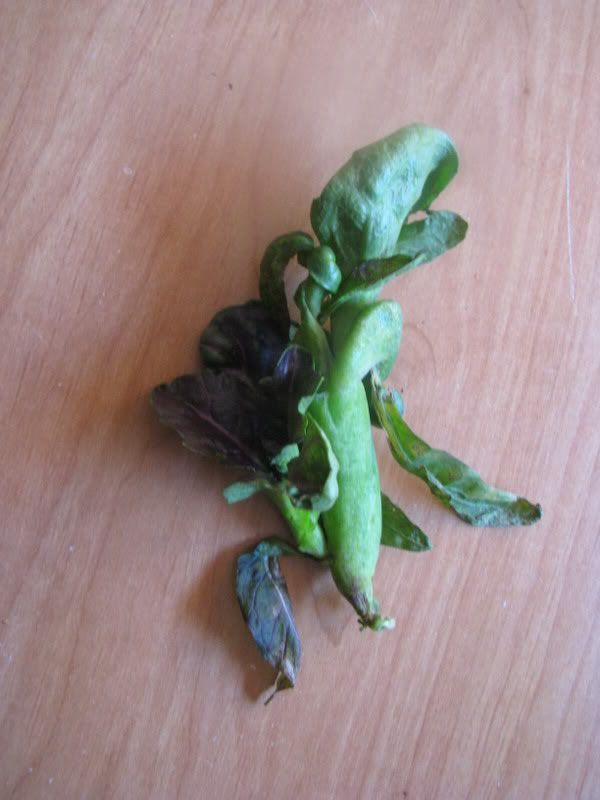
What is it? The petioles appear swollen which is a characteristic of some mustards and this bit of the plant was more cold hardy surviving a frost that wilted the rest of the plant. Not only that but it looks to me like a gall?
I broke it open and it is made of spongy tissue with no buggy inside that I could find. What is it? From the information I have found, I think it might be a gall from a swede midge.
Any clues?
Wednesday, October 29, 2008
Wordy Wednesday
My garden growing plastic. Why?
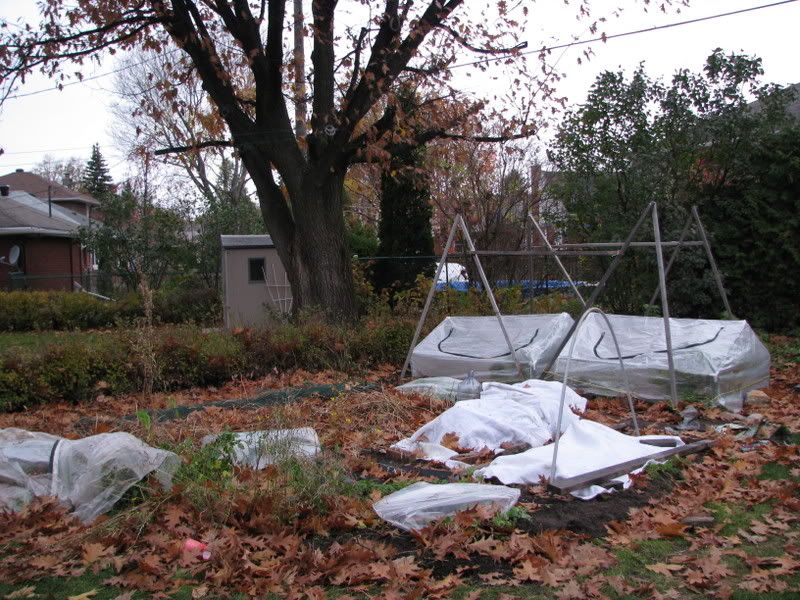
Unseasonably early snowstorm
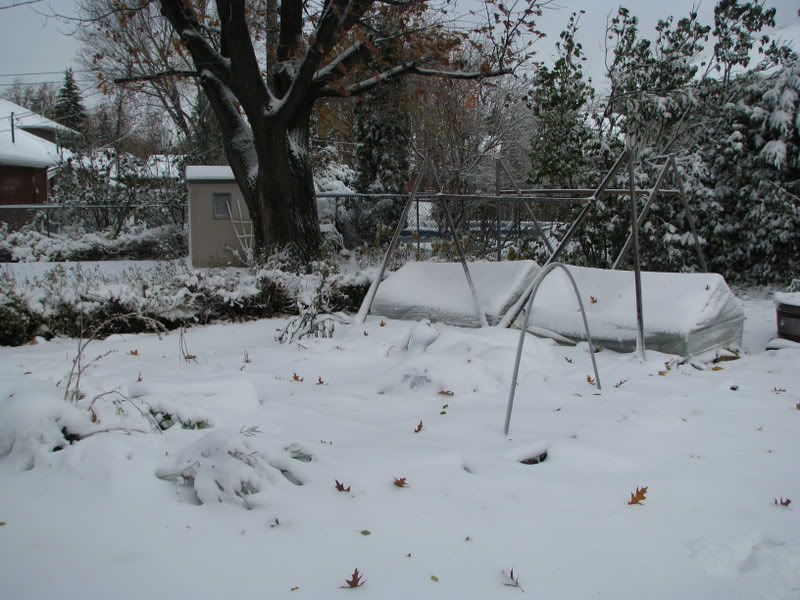
It should melt before the weekend is out (I hope) and then I'll have to play it by ear when to dig up the remaining root crops for cellar storage. I like to leave them in the garden as long as possible. You can see my half constructed polytunnel on the top picture. It will be different from the peaked polytunnel of years gone by but what it will look like not even I know.
***
What's wordless Wednesday. Well it's one of those meme things. You know a joint blog posting idea. I can't recall where it comes from and I don't normally participate because of my general wordiness but I bumped into a blog participating and figured what the heck.
Monday, October 27, 2008
Harvest Day - the roots of fall
Carrots, turnip, beets, scorzonera (black skin), jeruselum artichoke (bumpy thing), and salsify (thin white roots)
Freshly pulled are dandelion, chicory, beets, carrots, jeruselum artichoke, chinese artichoke, salsify, scorzonera, horseradish, sweet cicely, and turnip. Next year, I hope to add skirret (tried to grow these before but no luck), apios (already added thanks to a generous gardening friend), tuberous sweet pea (found a patch in Gatineau park), turnip rooted chevril, hamburg rooted parsley and more parsnip. I might even grow rampions (campanula rampunculus) but then again, I think it already grows in my yard as a weed.
From left to right: chicory, horseradish and sweet cicely (the last two look similar but feel and taste very different).
You may wonder why I have such a thing for roots but in the cold climate of Ottawa, a root cellar can mean the difference between eating store bought food and cooking from the fresh larder of your own garden. I am lucky enough to have an old cellar built under our front step which is the right temperature but a little dry for root storage. To compensate, I put bowls of water down there and sprinkle a little on top of my roots from time to time.Scorzonera, salsify (both collectively known as oyster root) and carrot
Also, some roots are great for forcing in the winter to produce fresh greens. Of the above, you can eat the leaves of dandelion, chicory, beet, carrot, scorzonera, horseradish (young leafs), turnip, and sweet cicely. Of course, you can also eat parsley but not the leaves of the turnip rooted chevril. Particular types of chicory are grown for the purpose of forcing them in darkness to produce tasty crunchy chicons for the gourmet market. Thankfully the plant itself is easy to grow in the home garden as are many roots.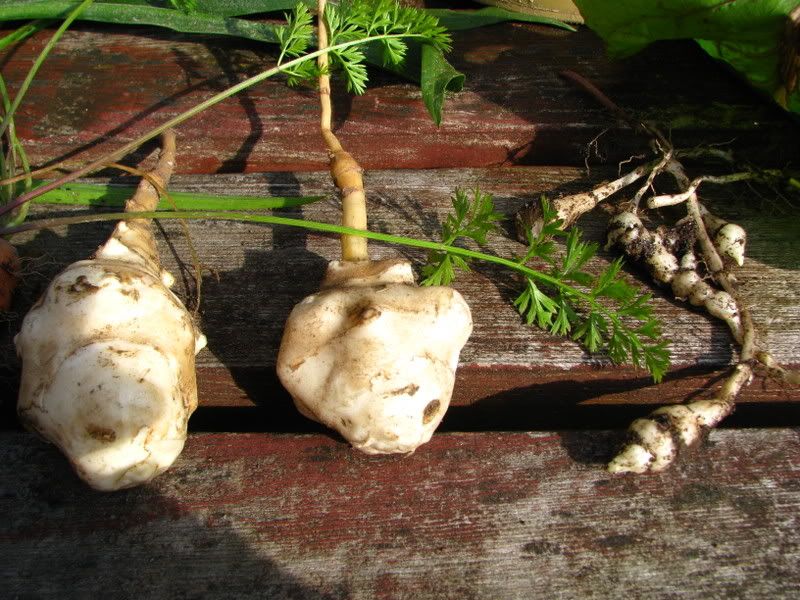
Left to right: Jeruselum Artichokes and Chinese Artichokes
Given a light soil (though there are varities of many of these vegetables that will grow in heavy soil such as oxheart carrot, egyptian beet and Russian Kral parsnip), roots require little space compared to other vegetables and some will even take a little shade. They are also the basis for many a meal from mashed to baked to fried to boiled. The famous 'root' used for these purposes is the potato which is actual a tuber but I am playing fast and loose with the definition here. Any undergrown food storage organ is being named 'root' in this post.
In Ottawa you can also grow Gobo (or wild burdock as I'm sure you know if you've ever taken a dog on a country walk), wild carrot / Queen Anne's Lace, short season sweet potato (I did last year with great success), tiger lily (really?), evening primrose, daylily (really, really?),jicama(according to Solana Seeds - who knew), chufa (have grown but was difficult to process) , dog's tooth violet (according to one source only survival food but it's pretty and native here), and many aquatic species such as the very useful cattail, and I'm sure I'm missing something.
-- inserted next day: how about radishes and rutabagas? (someone else should really be at the helm of this brain ship) --
I have the last two in my garden but extraction of a couple first year primerose rosettes revealed no tap root so I shrugged and moved on. The daylily I haven't tried yet.
* You can also cheat by digging a trench and filling it with loose soil or using a crowbar, shoving it into the ground, whirling it around to make a cone and filling with loose soil then planting your seed at the top.
***
Root storage and inulin
And now a fun little lesson. Inulin is a polysaccarhide that is used by many plants to store food. It can give people gas and if I remember correctly, it is one of the culprits in beans. In one of my wild edible food books, the writer talks about cooking roots with high amounts of inulin to break it down. Unlike many people who complain after they eat Jeruselum Artichoke of a gassy tummy, I don't normally react like that. I don't know if this is because of the variety I grow, the way I cook it or my own digestive system but I thought this was an interesting factiod.
More on inulin at Doc Weed's Doin's
Links:
Four Season Harvest by Coleman
Plants for a Future - has other roots that grow in milder climes as well
Wikipedia entry on edible roots with specific classifications between taproots, tuberous roots, modified stems and so on.
Friday, October 24, 2008
The Lastest - not seed saving but plant breeding...
***
Seeds of Diversity mag perched atop my favourite read of the moment. NRC (National Research Centre)'spublications Herbs of Canada and Vegetables of Canada.
If you want to be part of the ultracool organic, edible plant geeks this summer, then you have to do more than just save your seeds. Seed strain purity is good but if you really want to wow your friends and impress your neighbours, then a melon variety named after you is even better.
All kidding aside, I have noticed that there has been more and more talk about amateur plant breeding amoung seed savers. Perhaps it's just a natural progression. First you learn how to define OP and heirloom (let me know when you figure the exact definition of this btw). Then you get up the nerve to save more than just bean seeds. Next thing you know you are wondering if you can develop a purple podded snap pea or an early gold cherry tomato or, if your addiction has gone far enough, a perennial grain or a wide cross between two plant cousins. You have joined the ranks of the amateur plant breeders.
Even the cover of the latest Seeds of Diversity (great resource for gardeners/seed sharers/savers - check out their Canadian Tomato project) highlights this growing interest by featuring a generational digram of bean seeds. In this you see that the 'plant breeder' is not sure of the 'father' of his cross. Which brings me to the more haphazard version of plant crossing called 'accidental.' Of course, in the article he details and follows the accidental cross in a well planned manner.
I would describe myself as a more or less lazy plant breeder. I like to buy mixed seed packs of plants like mustard or beets and let them cross in my garden*. After awhile, I will then start to select my favourite outcomes of the cross and eventually (one hopes) get a strain of beets or whatever that I like. They may not be uniform and there might be a lot of rouging (getting rid of) inadequate varieties but I enjoy the variation. I also feel that the wider genetic variation will allow for yearly differences in pests, conditions and so on. Before any 'professional' amateur plant breeders read this and tsk-tsk my technique (if you can call it that), there are a lot of details that I have decided not to go into in this post just to keep the length down and to not bore to death those that haven't been overtaken by plant manipulation fever.**
It is also a bit inaccurate to call this a new trend. People have been selecting, intentionally or not, for improved edibles for as long as we have been eating. Just think of our ancestors choosing one fruit over another and then depositing the seeds in our 'special compost' near our dwellings perhaps even in clearings. Those seeds would get fertilizer and potentially more light. Then as we liked those fruit, we might have decided to weed around it a bit giving it all the more advantage and then eat the result etc... It just got more sophisticated from there.
This 'new' trend is reclaiming an art lost to many gardeners. A knowledge of genetics makes it less haphazard (ie. not my technique) and even more fun. For more on amateur plant breeding, genetics and techniques, I highly recommend Carol Deppe's book Breed Your Own Vegetable Varieties.
* If I offer seed varieities, I do try my best to ensure seed purity. In the furture, I might offer mixed seed but do you really want it?
** Seed saving is essentially plant selection which is why it is a good idea to know a little about plant genetics to avoid disappointment in future plantings.
*** I know I didn't have a third footnote? Don't let this scare you off seed saving, however, it is great fun.
**** Also a member of a plant breeders forum that seems to be based around a seed development company has recently left his url on my blog. If you are a plant breeder geek, you might be interestd in http://alanbishop.proboards60.com/index.cgi
Tuesday, October 21, 2008
The seed company less well travelled
I also visited (and promptly bought seeds) from Solana Seeds who have recently translated their webpage into English. Stunned by the number of plants including Piel de Sapo melon (a keeper melon), Red okra and more solanum berries than you can shake a stick at, I decided to try more french websites and bumped into La Societe des Plantes who made me swoon by selling turnip rooted chevril (I was beginning to think this veggie was a myth) and skirret (perennial 'carrot' relative) seeds. Both these Quebec companies also sold scozonera (another potentially perennial veggie I'm trialing here) which I could not easily find in NA prompting a kind European blogger to send me some seed from over there (I'm not linking him only because I don't want people to think of him as a courier ;-).
One final company that I quite like is Wild Garden Seeds as they genetically mixed seed packs so you can do your own selection for a variety suited to your microclimate.
Thought I'd bring these smaller seed company to the attention of locals and perhaps even those further abroad.
Monday, October 20, 2008
Show me your harvest day

Winter Keeper Tomatoes
For those unfamiliar with long storage tomatoes, they reputedly keep until New Years or Easter or some other far off tomato-less time. Often it is suggested that they are stored in idividual wrappers one layer deep not touching but Mapple Farms, my seed supplier, said he just kept his on a bowl in the kitchen and that sounded way easier. The type I have ripen from the inside-out which may be a common characteristic of long storage tomatoes but don't quote me.
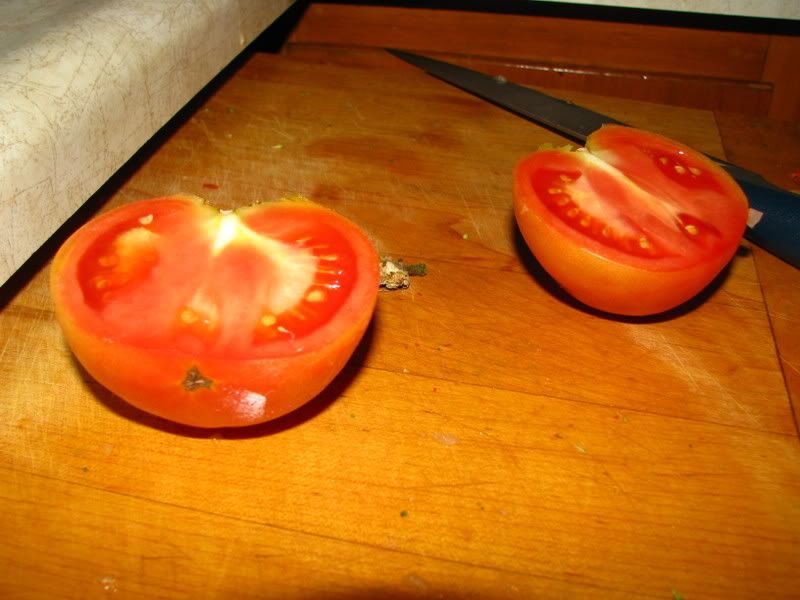
Cut open winter keeper. On the outside it looked icy orange and inside, red.
Anyhow, last year something happened to my plant so this is the first year that I have to really experiment. They do appear to be ripening a bit more slowly than other tomatoes that I brought in and I have only had one rot on me but I suspect that the skin had been damaged. I picked them from the just off green to blush stage before frost in late September and they have an acidic but acceptable taste that is far superior to a supermarket tomato, however much less sweet than a vine ripened one.
Also harvesting:
The veggie patch is still going strong after our first true ground frost of the year. We have brassicas including tatsoi, broccoli, cabbage, kale and mustard; roots like carrots and beets and soon to come are the unusual roots (post next Monday); lots of greens like rocket, chard, mache, minituna, salad burnet and so on; and crops like celeriac and florence fennel.
The coldframes are up but the polytunnel has to be constructed again this week as we are expecting dips to -5C. Soon will come the snow.
Links
Mapple Farms - winter keeper (my variety)
Sand Hill Preservation Centre - various storage tomato types
Friday, October 17, 2008
Blog Bounce
The reason why I am blog bouncing is because I'm trying to expand the blogs I read that are interested in edibles.
Thursday, October 16, 2008
Overwintering Peppers - 3 year old Fatali and friends
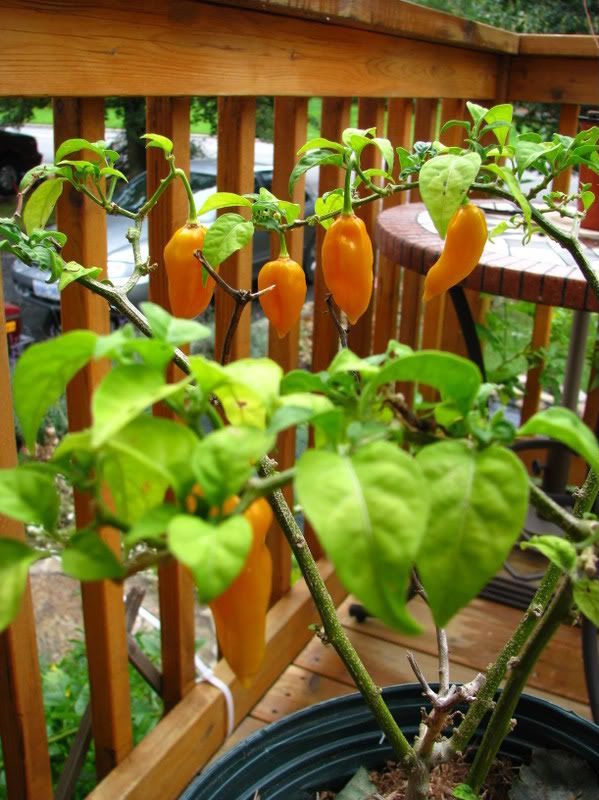
Fatali Habanero Pepper
Every once in a while, you learn a gardening trick that sticks in your brain like stubborn pine resin and this was one of them: Pepper plants are perennial; you can bring them inside and produce a crop from the same plant next year. As I have a tendency toward adventure gardening, I thought, "cool" so I did just that. The first year, my pepper lost all of its leaves and looked so dead that I threw it out. Further reading suggested that leaf loss was not uncommon so I tried again. The second winter was a fantastic success yeilding a crop of long cayenne even indoors. The third year I was plagued by insects and this year will be the fourth year that I try it.
I particularly like this method for hot peppers because though I love spicy food, I don't need an overwhelming mass of hot peppers at any one time and I find that this method provides me with two crops of the shorter season Long Red Cayenne instead of one bumper crop. For the longer season Fatali habanero, I get one crop ripening near first frost in September. In fact, it was the pathetic growth of what was previously known as 'four leaf fatali' that promted me to try again. It hadn't fruited at the end of the season and as my husband had picked it out, I thought I would try growing it a second season.
Other then the jalapenos that were devasted this year by a mystery malady (I was away much of the summer), I had thought I had all the hot peppers I needed until I took a stroll in the Canadian Agricultural Museum, aka the Experimental Farm (more on this garden soon). What did I see but a demonstration patch of varigated Fish peppers and some Medusa Head? (or small pepper plants that stick straight up in multiple hues of orange and red - all identifications are welcome). Some animal had rampaged through the patch leaving several pods strewn across my path. What could I do but rescue them? So next year, I intend on adding Fish, Fatali, and maybe Medusa Head to the party wintering over.
***
Gardening 201 - How to Overwinter Peppers
Pot to Pot
This is the easiest method, plant seedlings in a large pot and repot in something larger when needed. You might want to add compost tea every once in awhile as well. Bring out for the summer, bring in for the winter. The only problem with this method is that you have to remember to water well. I have had branches die back - even the whole top of the plant - from what I assume is drought. My solution this year was to mulch. The plants only received rain water so it seems to have worked. This year was however a bit of a soaker.
Pot to Garden Bed to Pot
I have done this as well and the plants grew much larger bearing heavier yields. Of course they were much more disturbed when about a month before first frost near the end of September, I dug them up. I have read that you should trim the roots and tops at this point but I have never done this.
Problems and Observations
Before bringing in your plant, observe very closely for whitefly, aphid, spider mites and the like. They are difficult to combat inside so do so outside while you can. If you do get an infestation in the middle of winter, you can try applying a light soap to water spray, rinsing off after 10 minutes or so. You can also just try jetting the plant with water to dislodge at least some of the interlopers. I would do this when I watered them about once a week. I also used the squish method of pest control by examining my leaves very regularly and manually smushing the pests. This kept them under control enough to keep them alive until natural predators cleaned them off in the spring outside.
Peppers are very frost tenders so you can start introducing them to real sunlight as opposed to that filtered window stuff as soon as daytime temperatures are warmish. For me, that's 10 degrees celcius. I usually have them in a covered coldframe. Increase the amount of time spent out each day in increments or if you are me, forget they are outside and start swearing when you see them in the evening looked bestraggled. Once danger of frost has passed, you can abandon them in pots in a warm, sunny place or plant them in the ground.
From my short time overwintering, I have noticed that my pepper plants will grow and crop well then show decreasing leaf size and then the leaf size will gradually increase and they will grow and crop well again. I haven't grown enough peppers to say that this is always the case but it has been for me in the two pepper varieties that I have inside.
So now you know, go ahead and try it. As for me, I'm going to try overwintering minature sweet bells next year too in order to see how they do. There is a rumour that the smaller fruited species overwinter more successfully.
***
Links
Most of the links are to my older gardening blog - Ottawa Hortiphilia which talks on length of my overwintering peppers saga.
Wednesday, October 15, 2008
Blog Action Day - The Seeds of Poverty
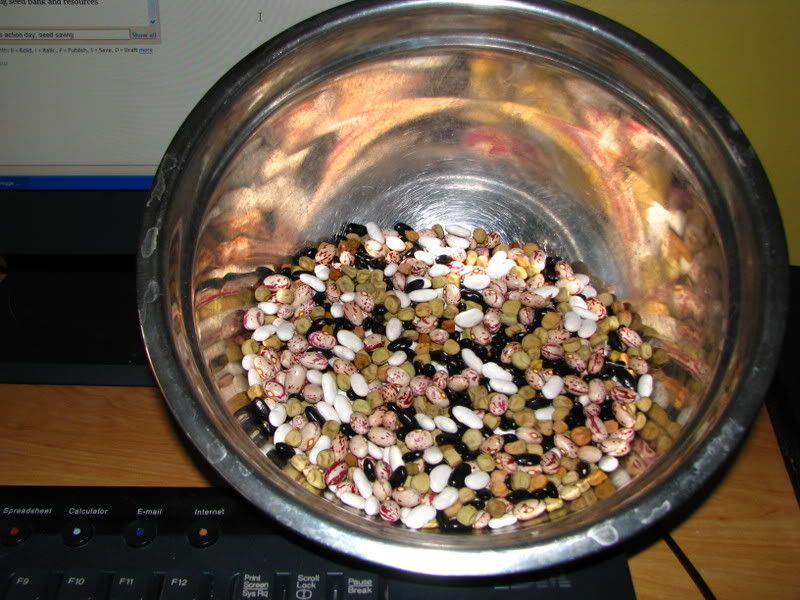
Computer and seeds from my garden
As a gardening blog interested in edible plants, it seemed natural to talk about seed security on Blog Action Day 08. Most of us plant crazed individuals know a little about seed saving, heirloom, open-pollinated and the such even if we do not actively participate. We also know that in places far away (Saskatchewan seems far away to me) there are seed arks that attempt to preserve the genetic diversity of our food crops in case the giant seed-opolies and lab seed-splicers get it wrong. And we get that it is poor people in those exotic far off lands that need protection from the dark shadows of imported patented seeds. That they need to save their seed legacies so that they be at least partially food self-sufficient. For it is food, or more importantly the lack of it, that most signifies poverty to many.
However, the scarcity of good food does not just occur in far off lands. The endangerment of plant diversity and local seed legacies certainly is not just happening somewhere else. And most importantly there are seed banks existing all around you - living seed banks.
When you choose to grow open-pollinated seed and save it, you are participating in the maintenance of genetic diversity, but there is more. You can choose to save extra seed and give it to someone. If you are gardening fanatic anyhow, it is no torment to skip around town suggesting that this patch of dull lawn be turned into a garden and by the way, here are a couple packets of seeds to plant in it.
For many urban poor, it is good produce that is hard to come by as mass produced 'inorganic' veggies, sometimes processed out of recognition, are the cheapest eats. You can work locally to create community gardens or to volunteer your time to demonstrate alternative gardening methods (check out these kiddy pool gardens). If you do not have time to do that but have the garden space, you can also participate in the Grow a Row initiative. Just plan for part of your harvest to go to the local foodbank at participating communities. Heck, if you don't live in a participating community, why not try and change that?
***
Nitty Gritty on Seed Saving
Not all plants reproduce equally so if you want to know if you can properly save seeds of a particular plant, Seed to Seed by Ashworth is a great start, along with innumerable other books. Some plants need large populations to ensure that the offspring are vigorous, others can potentially be saved from one plant. Some need to be grown two years to grow a seed stalk, others will give you seed in the first year. Here is a list of easy seeds to save:
Peas
Beans
Tomatoes
Lettuce
P.S. I have chiapas wild tomato seeds available for those interested.
***
Some of those links again:
Bloggers Action Day
Plant Gene Resources of Canada - Gene Bank
Seeds of Diversity Canada - seed saving and sharing, living seed bank and resources
Community Gardens in Ottawa from Just Foods
Grow a Row - growing for food banks

Beans saved from my garden: short season chickpea, purple podded pea, speckled cranberry bean (originally saved from grocery store pods), white broad bean (hmmm... variety?), cherokee trail of tears bean

